Abstract
As a specific human activity, playing constitutes a fundamental type of activity in childhood through which is carried out in the highest degree of mental health development by psychomotor sensory entertainment, intellectual, and emotional. The playful conduct represents an aspect of the substance of the human ability to specify the means and to express. The clearance is the means by which the child manages to solve certain contradictions that appear in real life to which a charged with limited opportunities of knowledge. Up to 6 years the play is both the manifestation of spiritual life of the child through meet the wishes and releasing the internal tensions, as well as the way to training and development of mental capacities. The deficit of playing in childhood affects the degree of socializing, thinking, the imagination, the language as well as the capacity to act. The work has as its objective to identify the features of the game at the preschool age, role to play in the acquiring of specific knowledge of range, as well as the establishment of a correlation between the level of involvement of children in the games and the volume of acquisition of knowledge. On the basis of the scales of observation of the playful behaviour of preschool children have been established a positive correlation between the level of the child's activism within the game and the results of the specific school acquisitions.
Keywords: Playlearningcooperationdevelopmentacquisition
Introduction
The first years in the life of a child are essential for the later psycho-physical and social development. The game is the most important source of development, as the activity which gives the child the opportunity to interact with others, to explore the environment, to find solutions to the problem situations, to express its emotions, to acquire knowledge and skills that will be necessary in order to adapt to the requirements of the social life. Popescu-Neveanu (1978) defines the game as "a form of specific activity for children and decisive for the development of mental health" (Figure
At different times of life, the child's play offers precious acquisitions, and everything that represents the decisions of the private life of the child, start from the original form of the word game. The game is a fundamental activity of the child and represents the main maturing process, mental and emotional development.
Play through the child shall meet as soon as possible, their own desires, by pressing the conscious and freely in the imaginary world on which it creates alone. The game is for the child at the same time, entertainment, and Recreation but vitally needed for the reconstruction of the reality which makes adults to believe that a child who is playing is storybook scheme. The child playing builds a world, a personal approach, analyses it and try to understand (Elkonin, 1980).
In the game and the game is performed knowledge of reality, is practiced and socio affective psychometrics functions; the game is at the same time an agent of the transmission and the social experience. For the child, almost any activity is a game in which puts into practice the functions which the social environment can leave disabled. The game is triggered latent skills, virtual, treated in the same way but unconscious, which combines and develops in an activity which shall be arranged and on which at playing a coordinate in consensus with the specific aspects of his personality (Claparède, 1975).
Problem Statement
From the psychological standpoint, the game responds to the natural needs of activity, the acquisition of experience, the statement by the performance of conduct. The game is the essence and reason of childhood. By game the child aspires to the condition of adult, he is firing and supporting social mechanisms, "he prepared for the future, satisfying the needs of present" (Claparède, 1975, p.51). In the game the child learns, causes creativity and making any effort of work activities without fatigue to lead to exhaustion or boredom. The child has the opportunity and freedom to try to make various things in his staff, the game being pleasure and satisfaction at the same time.
Learning defined as "an evolutionary process, the essence of the formative one-information, consisting in the acquisition ( reception, storage and internal exploitation ) by living creature, in a manner which is active, explorative of own experience and, on this basis, the selective and systematic change of behaviour, in the improvement and development controlled and continue under the influence of the variables actions of the environment has as its main source to the preschool age play (Golu, 1985). (Figure
The child learns to act with others, to express their emotions, to acquire the knowledge and skills required later to adjust to the requirements of the school (Figure
Research Questions
The idea of the objectives which it has gone was based on the establishment of the empirical as through the involvement of children in age-specific games they acquire specific knowledge of range.
The overall objective of the study is the identification of the characteristics of the game at the preschool age, role to play in the purchase of specific knowledge of range, as well as the establishment of a correlation between the level of involvement of children in the games and the volume of purchases of knowledge.
Purpose of the Study
The study was attended by a number of 20 subjects, aged between 3 and 6 years (8 girls and 12 boys, who have regularly attended kindergarten at the age of 3 years.)
Research Methods
For the achievement of the objectives there have been used psychological observation and conversation. The psychological observation has been carried out on the basis of the observation grilles with 3 items and 3 steps (always, sometimes, never) the characteristics of the game at the pre-schoolers, of the results of the experiential learning in the field of language and communication and learning results in the field of experiential Sciences; The conversation worn with both children and the professor was a great help, because he served for details on the information obtained as a result of observation. We help the advantage that the researcher interacted with the subjects, receiving the feed-back verbal and Nonverbal.
Findings
To highlight the results in the field of language learning and communication has been used a game teaching staff, with the aim of the education of a verbal expression correct from the point of view of grammar, to develop the capacity for knowledge and understanding of the environment, as well as the stimulation of curiosity to investigate, deepening of knowledge relating to the environment (Figure
Educational chore of this game was the correct use of singular and plural the wording of sentences correct from the point of view of grammar, find the answers to riddles, the recognition of certain flowers, insects, migrating birds, completing a "pyramid" by the ordering of inspiring images.
In the field of experiential science has been carried out a game with the aim to develop the capacity of knowledge of numbers, stimulating curiosity to find a solution and to solving the problems, deepening of knowledge relating to the mathematics.
Educational chore of this game was counting in ascending and descending order, reporting numbers, find the numbers to solve the problems of the neighbours, simple, find the answers to riddles, the formation of the crowds and the correspondence of numbers.
Use the grid of observation of the playful behaviour have been evaluated by reference to a scale of measurement with three steps for which it has been granted following score: Yes, respond properly and completely 2 points, the answer completely part 1 Point, Not Responding or incorrect answer 0 points. By analysing the characteristics of play at the preschool age to our subjects of the consignment shall be established following allocations according to the variables specified:.As regards the nature of the game at the preschool age have been identifying the following:
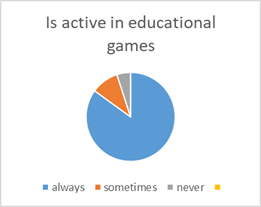
They have been recorded that preschool children are active in proportion of 85% in the framework of the didactic games and only 5% never, because their age is smaller.
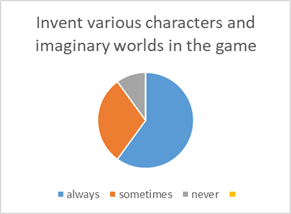
In the proportion of 40% preschoolers invent different game characters and Imaginary worlds, 30% fabricating sometimes, because they are not interested in stories.
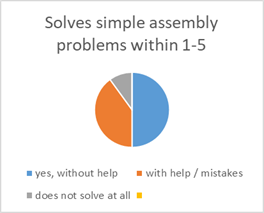
I identified as pre-schoolers at a rate of 50 % resolve problems simple meeting within the limits of the 1-5 and at a rate of 40% resolve them using the teachers help. This demonstrates that they do not master so well the acquisitions in the field of Science.
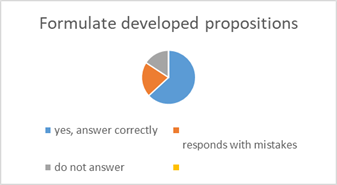
60% of the preschoolers need help to formulate developed sentences, and 15% do not have yet their vocabulary formed.
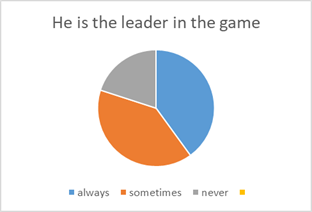
On the role of the leader within games, preschoolers are divided in a proportion of 40% as always and an increasing proportion of 40% sometimes. In this percentage documents show that they are equal in the games.
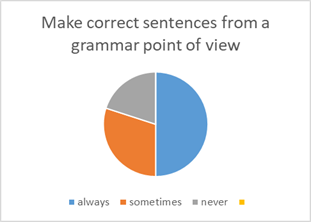
Having regard that the pre-schoolers age is between 3 and 6 years, in a proportion of 50% sentences correctly formulated from the point of view of grammar, and 30% of them have need support in and deepen their knowledge in the field of language and communication. Active character of the game is apparent from the fact that at the rate of about 90%, children are active in the game, is involved in teaching games, initiates the clearances and are the leaders of the game. These features of the game, denotes that the preschool age children who are active in the game were superior results to lifelong learning as the interaction of children with the game is an essential factor and in their development.
On investigating these correlations between the game characteristics and the acquisition of knowledge that the results of the learning of the following facts were established: by correlation with the results of the DLC(language and communication) and DS(sciences), children playing sometimes alone, I found that do not have very good purchases linked in the field of language and communication, as well as in the field of science, as well as the child playing alone. This demonstrates the fact that they did not have interacted with the environment and with people around or still in the first months of life, and because of this have some moments when they are overwhelmed and even frightened by the behaviour of the children playing in the group (for example, make noise, are they saw, etc.).
Research and proposed to investigate the extent to which the game supports learning at the preschool age. I noticed that, free play is the one that has driven touch language helping children to acquire more information in correlation with the field of language and communication and sciences, but also to develop their mental processes, such as memory, thinking, the perception, representations, imagination and language.
From the results of the research, I found that there is a need for carrying more similar exercises, to be fixed concepts as well, and as regards the free play and learning, they are very closely linked and by the fact that the involvement and the enthusiasm of the child is seen in carrying out the tasks carried out, the game stimulating the activity of learning. We find, that pre-schoolers who have been active in the game and rich vocabulary and have acquired the information in the field of science.
Conclusion
Therefore, the assumptions and research objectives have been confirmed by the fact that at the rate of 90 % the active involvement of children is evident from the characteristics of the game, as the leaders of the game, initiating and involved in the game, and as regards the results of higher learning pre-schoolers which are active in the game, denotes that the interdependence of children with the game represents the expending of the fundamental factor in the horizon. By means of the game the child acquires information, and the integration of the concepts necessary for the understanding of the real world. Through his investigations into the various physical realities, the child handling, choose, classified, measured, familiarizes with the properties of objects and acquired knowledge about the weight, hardness, height, volume, texture, categories, series and families of objects. In the sweeping across the game experience through the child acquires a profound thinking, ideas and abstract concepts that you need to become adults.
References
- Claparède, E. (1975). Psihologia copilului și pedagogia experimentală [Child psychology and experimental pedagogy]. București: Didactică și Pedagogică.
- Chateau, J. (1970). Copilul şi jocul [The child and the game]. București: Didactică și Pedagogică.
- Elkonin, B. D. (1980). Psihologia jocului [Game psychology]. București: Didactică și Pedagogică.
- Golu, P. (2001). Psihologia învăţării şi dezvoltării [Psychology of learning and development]. București: Fundaţiei Humanitas.
- Popescu-Neveanu, P. (1978). Dicționar de psihologie [Dictionary of psychology]. București: Albatros.
Copyright information

This work is licensed under a Creative Commons Attribution-NonCommercial-NoDerivatives 4.0 International License.
About this article
Publication Date
15 August 2019
Article Doi
eBook ISBN
978-1-80296-066-2
Publisher
Future Academy
Volume
67
Print ISBN (optional)
-
Edition Number
1st Edition
Pages
1-2235
Subjects
Educational strategies,teacher education, educational policy, organization of education, management of education, teacher training
Cite this article as:
Lăzărescu*, M. P., & Pîrvulescu, I. G. (2019). The Relationship Between Play And Learning At Preschool Age. In E. Soare, & C. Langa (Eds.), Education Facing Contemporary World Issues, vol 67. European Proceedings of Social and Behavioural Sciences (pp. 1440-1446). Future Academy. https://doi.org/10.15405/epsbs.2019.08.03.177
